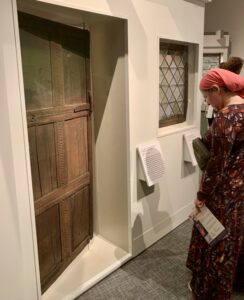The Peabody Essex Museum in Salem, Massachusetts kicks kitsch to the cobblestone with it’s exhibition “The Salem Witch Trials: Restoring Justice”. This presentation of artifacts is a serious and timely review of relevance. Not only are the displays authentic but of equal importance, the exhibit explores with empathy the unintended consequences of a tribal-war flamed by suspicions, religious virtuosities, and pervasive social anxieties.
The scope of The Salem Witch Trials broadens reflections on the meaningfulness of restitution and the significance of recognition not only for the families directly involved, but for society as a whole. What is not part of this exhibit are the parallels between Salem’s persecutions of the innocent and victims of today’s war in the Middle East. The context of those geopolitical tensions and atrocities is food for independent thought.
PEM’s priceless collection of domesticities used by both the accused and accusers of witchcraft, instills each gallery with a sense of relatability. A period front-door beckons guests to explore objects commonly found inside a settler’s home. Inevitably, intrigue creeps over the transom spiriting guests to appreciate a ‘valuables-cabinet’, a glimmering sundial and a highly personalized weaving board. Each piece is part of a complex chapter in American history. These artifacts are also simple memorials to the souls whose names will forever be shrouded by dark shadows.
Ordinary pieces of humanity landmark the extraordinary witch-hunts of 1692.

At that time, in Mass Bay Colony, any accusation of witchcraft would transform a window, a walking-stick or a hand-sown sampler into a generational life-sentence of social injustice. A claim of spectral possession lead to an immediate presumption the owner was a practitioner of witchcraft.

Mary Holingworth (English) sampler 1665
Cries of innocence, denial of guilt and pleas begging for mercy were unheard. Salem became a cauldron of fear.
Paula Richter, curator of “The Salem Witch Trials :Restoring Justice” said a perfect storm of anxieties fueled irrational thinking. Puritans and Quakers seeking religious freedom in New England were suspicious of each other. Never-ending boarder-wars divided the colony. Harsh weather, poor harvests, high maternal mortality rates and conflicts with Indigenous Peoples contributed to an atmosphere of psychological exhaustion. Richter believes the social-pressure-cooker lead colonists to welcome distraction. When darkness came to homes overburdened by reality, wild imaginations sparked wilder accusations.

Pauline Richter, PEM Curator of” The Salem Witch Trials: Restoring Justice”
As relatable today as they were 300 years ago, the collection of artifacts casts a spell over Museum guests to wonder ,” What would I do if they came for me? ” To claim innocence ensured a death sentence. Visitors with heart can imagine the sense of panic. The terror of persecution upended their lives.
Contributing gravitas to the multi-formatted exhibit PEM displays images of handwritten Witch Trial documents.The transcripts are evidence of a history of histrionics and confirm judges knew there was no reason to charge anyone with ‘possession’.

June 1,1692 Court testimony of Mary English
Yet, 25 men, women and children we sentenced to death.
When accusations exceeded more than 200, prisoners were jailed outside the immediate vicinity. There, more rational minds cooled the fever to kill innocents. Logic coupled with guilt abruptly ended the Witch Trails. The burden of justice remains unresolved.

Wall planks from the Salem jail built in 1684
This exhibit is the antithesis of a cartoonish caricature of The Witch Trails. It is sobering for it’s cultural sensitivities bearing witness to a community tangled in a hell-bent campaign to sanitize society.
Juxtaposing the zeitgeist of Salem in 1692 with today’s war between Jews and Muslims amplifies the heartbreak of ‘The Salem Witch Trails”. The sensation of history repeating itself is palpable in galleries that revisit a flashpoint that implausibly triggered families, friends and neighbors to became foes without compassion or sense of humanity.
Feel it now ~ November 26, 2023
Discover more from She The People News explores the world of business, culture and politics from a woman’s point of view.
Subscribe to get the latest posts sent to your email.

